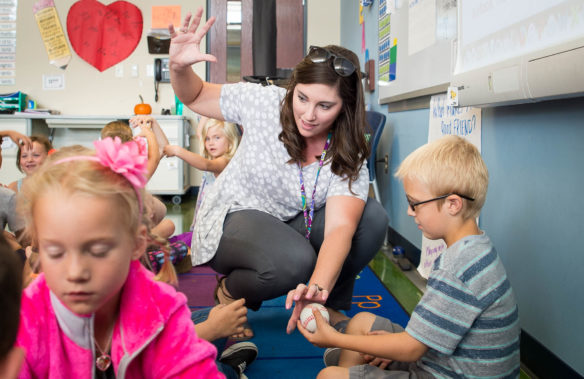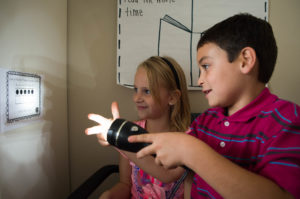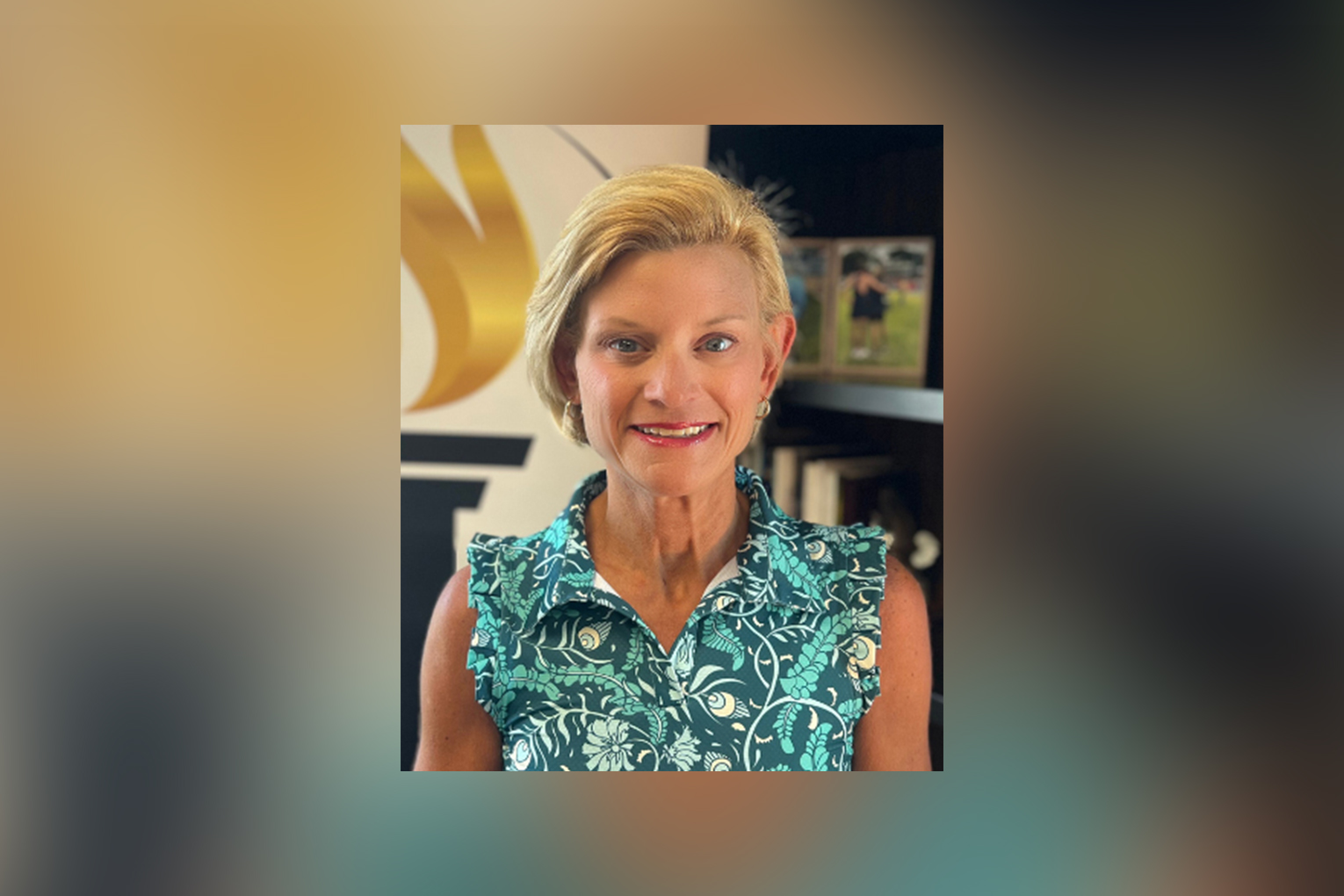
Kara Northern explains shadows to a student in her 1st-grade class at Jody Richards Elementary School (Warren County). Northern is testing a unit of lessons as part of an initiative led by Boston public television station WGBH in collaboration with NASA that is developing new instructional models and digital media tools for STEM classrooms.
Photo by Bobby Ellis, Oct. 17, 2016
By Mike Marsee
michael.marsee@education.ky.gov
Kara Northern was looking for something that would make her a better teacher. What she found was something that could help not only her, but also countless other teachers.
Northern is testing a unit of lessons in her 1st-grade classroom at Jody Richards Elementary School (Warren County) as part of an initiative that is developing new instructional models and digital media tools for STEM classrooms.
She was one of 50 teacher advisers selected for “Bringing the Universe to America’s Classrooms,” a program spearheaded by Boston public television station WGBH in collaboration with NASA.
Northern’s participation in the program is helping her implement the Kentucky Academic Standards for Science in her classroom. The resources she and the other teachers are helping to develop will be distributed through PBS LearningMedia, where they can reach millions of students and teachers nationally.
“I want to be the best teacher that I can be,” Northern said. “PBS is a great tool for our teachers, and I was really interested in the program since we’re implementing the standards at my school. Getting to work with this program fit hand in hand with implementing those standards.”
Rae McEntyre, a science consultant at the Kentucky Department of Education, said this will be a wonderful professional learning experience for Northern.
“This is an exciting opportunity for her,” McEntyre said. “Not only will her young students benefit through the rich experiences they will participate in, but she will be able to provide some insights into what may be happening across the country with science education as she networks with other teachers.”

Olivia Wells, left, and Micah Tanner, 1st-grade students at Jody Richards Elementary School (Warren County), use a flashlight to cast shadows on a wall during a demonstration in Kara Northern’s class.
Photo by Bobby Ellis, Oct. 17, 2016
Northern is teaching “Sun, Light and Shadows” over a two-week period to her class of about 20 students. Once she has finished the lessons, she will submit feedback to WGBH, answering questions about how long she spent on the lessons and how they were implemented.
“Once they gather all of our info that we give them, they’re going to look and see if they need to tweak anything else,” she said.
After being selected to participate in the “Bringing the Universe to America’s Classrooms” program, Northern was assigned to a diverse group of teachers from grades K-12 who reviewed the material for their grade level in a series of virtual meetings.
“We had a couple of weeks to look over the materials, and we were able to think about how we would use them in our classroom and what would work and not work. We met again to go over the feedback that we had and talk through any glitches,” she said.
Northern said she was interested to hear how other teachers were using the materials – some used them for enrichment, others in one-on-one instruction.
“I’m using them in the whole class. I want all of my kids to experience them,” she said.
Northern’s first lesson introduced her students to shadows and how they are made. She used a Smart Board to explain the concept and provide illustrations. She brought students to the front of the room to form shadows with their hands, then sent all of the students around the classroom with flashlights in search of objects that cast shadows before they returned to the board for an interactive game.
Minutes later, Northern said she already was thinking about the feedback she would offer on that lesson.
“I’d like to have just a little bit more explore time as opposed to reading about what’s going on,” she said. “But overall, I think it went really well and the kids had a lot of fun.”
Subsequent lessons offered more explore time, including an outdoor activity in which the students “chased” the sun’s shadows on the basketball court, then revisited the court later in the day to note the shadows’ progression.
Northern, who is in her fourth year at Jody Richards Elementary, said these lessons could help primary teachers who might find it difficult to work science into their daily schedule.
“The lessons are very helpful if you may not be too familiar with science, and they’re very well put together,” she said. “I feel like some teachers think that science is overwhelming or maybe they can’t fit it into their day, but you can always integrate reading and science together. They go hand in hand, and this is a great way to do that.
“I’m pretty adamant about getting science into the classroom. I really integrate it through reading and any other moment in the day that I can. I really think it’s important for students to see how the world works.”
MORE INFO …
Kara Northern kara.northern@warren.kyschools.us









Leave A Comment